Nicole schreibt...
French Polynesia Cruise 2014 |
 |
The South Pacific is probably one of those once-in-a-lifetime dreams many people dream - at least it was for me. So when my mother decided she had money to burn and take me there as a special present for a big birthday, of course I happily said yes. My initial hope to see all the fabulous islands I dreamed of - Tahiti, Samoa, Fiji and so on - soon got a reality check when I realized just how much space that area covers and that a cruise to all these locations would take months. So instead I settled for the place I wanted to see most - Tahiti in French Polynesia and its surrounding islands like fabled Bora Bora, island of the super-rich honeymooners. My mother with her love for cruises wanted to be on a boat and the only truly sensible choice here was the MS Paul Gauguin, a fairly small luxury vessel that focused on French Polynesia entirely and had space for only about 300 passengers, so the little islands wouldn't be swamped with tourist hordes.
Since their super special package offer included airfare from Los Angeles, we had to arrange our trip via California, though that ultimately turned out the much better route compared to New Zealand anyway (a country I'd love to visit as well, but rather as a complete trip sometime). And since it made sense to do stop overs between the long flights, I decided that it would be nice to show the mother around San Diego, which had been my favorite city during my first California trip a few years ago and which I wanted to revisit again as well.
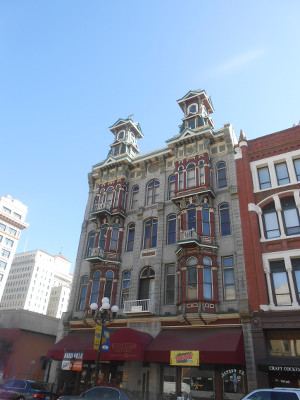 |
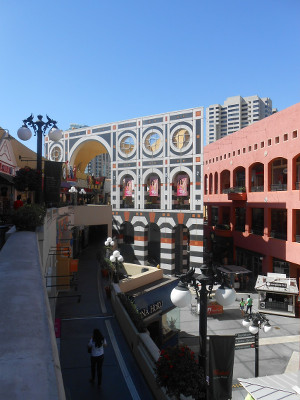 |
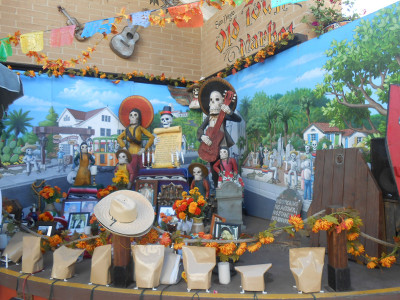 The first walk around town was basically retracing my steps from our fancy hotel to the harbour with the USS Midway (which I had seen the first time round), the touristy but pretty Seaport Village and along 5th Avenue through the Gaslamp District to Horton Plaza Mall. San Diego was boiling in unseasonally high temperatures, so a midday break at the hotel pool was welcome before setting off again, this time for the Old Town State Park, a typical American living history set up with a very Mexican vibe to it.
The first walk around town was basically retracing my steps from our fancy hotel to the harbour with the USS Midway (which I had seen the first time round), the touristy but pretty Seaport Village and along 5th Avenue through the Gaslamp District to Horton Plaza Mall. San Diego was boiling in unseasonally high temperatures, so a midday break at the hotel pool was welcome before setting off again, this time for the Old Town State Park, a typical American living history set up with a very Mexican vibe to it.
Back during my first trip most of the buildings had already closed for the day but we found it in full swing now - the main street lined with Mexican restaurants and souvenir shops (all gearing up for the Dia de los Muertos with its fairly macabre skeletons) and the State Park itself, recreating the early San Diego of 19th century with historic shops and buildings. It was great to see it all so lively now and this alone was for me worth the return to San Diego:
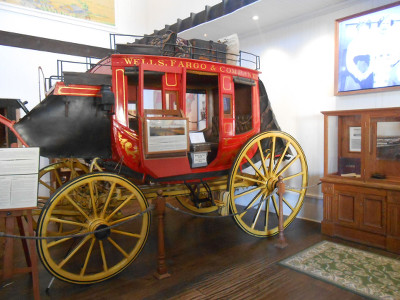 |
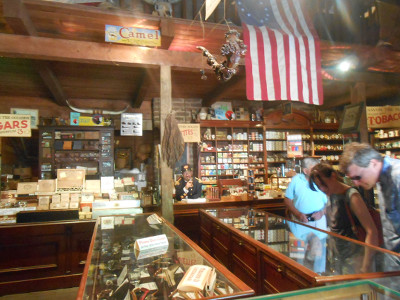 |
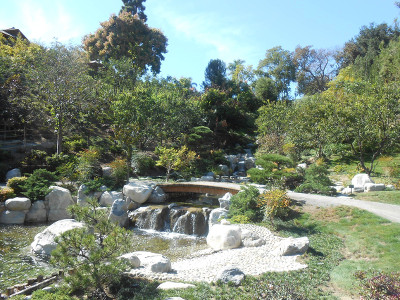 |
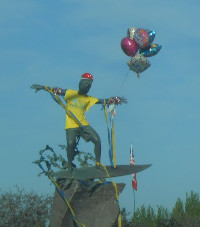 Some might scoff at the "fake" Spanish architecture, but I personally think it's a thousand times nicer looking and certainly more original than all the bland modern architecture blighting cities all over the world. So needless to say that I loved Balboa Park and would have liked to linger longer. Instead we returned to the Gaslamp District for one last Mexican dinner on Fifth Avenue and next morning drove along the glorious Pacific Highway where Californian Surfer Culture is alive and kicking. We almost gatecrashed the huge military Camp Pendleton when the highway suddenly ended but luckily the marine on duty was a nice fellow and immediately believed we were just dumb lost tourists. Probably looked the part (ahem).
Some might scoff at the "fake" Spanish architecture, but I personally think it's a thousand times nicer looking and certainly more original than all the bland modern architecture blighting cities all over the world. So needless to say that I loved Balboa Park and would have liked to linger longer. Instead we returned to the Gaslamp District for one last Mexican dinner on Fifth Avenue and next morning drove along the glorious Pacific Highway where Californian Surfer Culture is alive and kicking. We almost gatecrashed the huge military Camp Pendleton when the highway suddenly ended but luckily the marine on duty was a nice fellow and immediately believed we were just dumb lost tourists. Probably looked the part (ahem).
After dropping off the rental car (yes, ANOTHER Mustang Convertible) at LAX, Air Tahiti Nui whisked us off to paradise on another eight hour flight (on a surprisingly ratty old plane considering what a high-end destination French Polynesia is).
At Faa'a airport we were ferried off to the port of Papeete where the MS Paul Gauguin was waiting for us. A lovely little ship indeed where we had booked a gorgeous balcony stateroom but my joy at finally being in paradise was seriously shattered by realizing that I had forgotten my Kindle, and thus all my reading material, on the plane. Luckily the ship had a little library, but that didn't make up for losing all the South Pacific-themed books I had gotten. And to top it off, my camera had broken as well. What a start!
The Paul Gauguin left Papeete before midnight and steamed through the night to fabulous Bora Bora - where we dropped anchor near Vaitape, a one-horse-village that passes for the main settlement of the island and consisted of little more than a handful of souvenir shops, two banks, a post office and a supermarket. It gave me a foretaste of what was to come.
Here's Vaitape and Bora Bora itself, dominated by the volcanic Mount Otemanu:
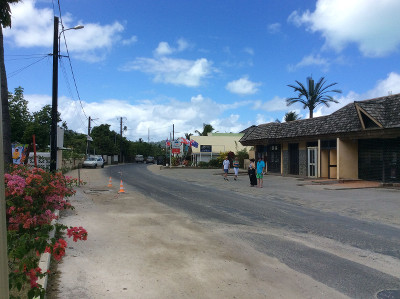 |
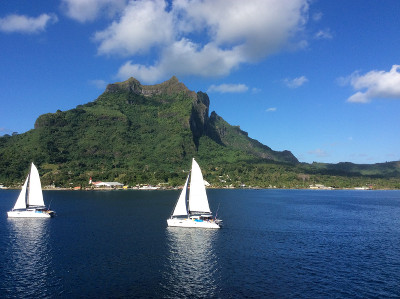 |
On the third day we departed for Taha'a, the "vanilla island", though we didn't make it onto the island proper. The cruise company owned another motu here and pulled out all stops for an amazing beach day for its guests. There were sunloungers everywhere, free drinks, a huge barbecue for lunch, Polynesian music and a couple of stalls to shop for local stuff. I was also pleased that except for one "kayak race" in the early afternoon there was none of the silly tourist animation, leaving people to do their own things, whether just being lazy in the sun, snorkelling or exploring the area by kayak. Here are pictures of the motu and the beautiful sunset that awaited us on departing later:
Next stop was the island of Huahine, where we had actually booked a tour that would introduce us to the ancient Polynesian culture and its traditions and beliefs, led by a very chatty American guide who could go on for ages. But it was interesting nonetheless as we were taken to one of the most important "marae", the meeting places of the Polynesians of which not much is left today except for some stones in strictly symbolic arrangements. Other structures of wood and similar light building materials were long gone (usually torn down by overzealous Christian missionaries), though a similar building had been set up next to the marae to give an idea of what things looked like.
The tall wooden things being used to decorate graves and honor the spirits of the ancestors. While the island of Raitatea held the most important marae, dedicated to the Polynesian deity Oro (the God of War), Huahine came a close second and Maeva holds the largest complex of marae on the island, where clans from all over French Polynesia came to congregate.
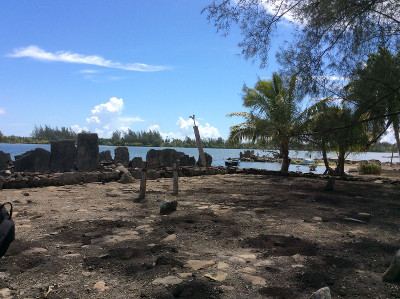 |
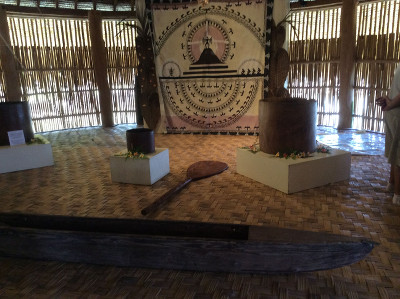 |
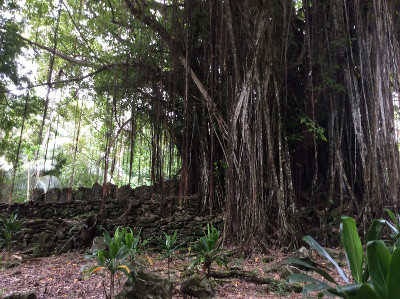 |
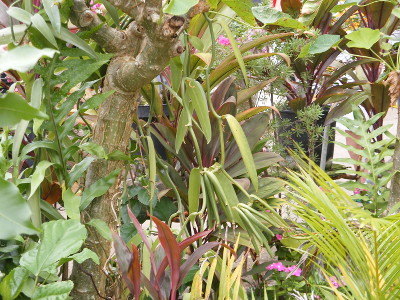 |
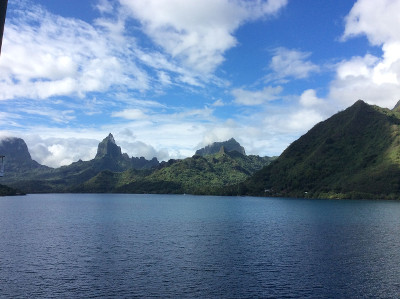 Our last island was Moorea, a nearly heart-shaped island dominated by two extensive bays on the North Coast, Opunohu Bay and Cook's Bay. The latter being a misnomer since Cook anchored (like we did) in Opunohu Bay. Tender boats took people to the small settlement of Papetoai which boasts the oldest European structure of French Polynesia, the octogonal little church planted there by English protestant missionaries in 1822 (below left).
Our last island was Moorea, a nearly heart-shaped island dominated by two extensive bays on the North Coast, Opunohu Bay and Cook's Bay. The latter being a misnomer since Cook anchored (like we did) in Opunohu Bay. Tender boats took people to the small settlement of Papetoai which boasts the oldest European structure of French Polynesia, the octogonal little church planted there by English protestant missionaries in 1822 (below left).
Activity for the day was a rather odd "Aquawalk" where your head is stuck into a diving helmet and you can walk underwater for some time while being fed air through a long hose from the boat. It was something my mother had really wanted to do since she freaks out when her head goes under water and thus isn't able to do proper snorkelling. Hoping she'd feel different when her head would stay completely dry inside the helmet. It all went well with the sweet diving instructor holding her hand throughout, while personally I would be just as happy to just snorkel and watch the amazing tropical fish in that particular lagoon in Moorea from above. The cutest part were the two playful stingrays though (here's one) that fussed around the boat and the divers all the time like playful puppies (and felt rather rubbery and iffy):
My own gig came the next day when I had privately booked a horse-riding tour through Opunohu Valley and its pineapple plantations, thinking it would be a wonderful way to explore the nature. And although it was raining half the time, it was indeed a fantastic experience. I was picked up at the quay on Papetoai in the morning and taken to the ranch (where, luckily, we were given rain ponchos) then set off through the valley, admiring the gorgeous untamed scenery all around.
The valley is also known as the Vallée des Ananas because pineapples are being grown here. I realized that oddly enough I had never known how exactly pineapples grow. On trees? On bushes? On the ground? Well, here's the solution:
Our guide actually plucked a pineapple and served it to us after the ride - it doesn't get fresher than that! Since one couple had to be taken back to a resort near Maharepa (something of the main town on Moorea, though really another one horse-village) I also got a nice tour along the northern coast and Cook's Bay and Opunohu Bay before being delivered back to the quay at Papetoai and the ship.
That last evening we were once again treated to genuine Polynesian performers offering a great song and dance show in the theatre after dinner while the Paul Gauguin finally made her way back to Papeete on Tahiti. While roaming around paradise had been rather lovely, I admit I was quite happy to see the many lights of a proper town again when we finally docked in the evening.
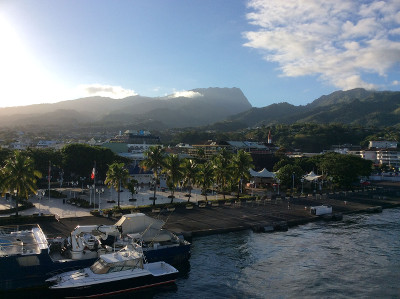 Here's the view from our balcony to the central square of Papeete where every evening the "roulottes" (the Tahitian equivalent to South East Asia's hawker stalls) set up shop and half the town congregates to eat, chat and play loud music.
Here's the view from our balcony to the central square of Papeete where every evening the "roulottes" (the Tahitian equivalent to South East Asia's hawker stalls) set up shop and half the town congregates to eat, chat and play loud music.
While the cruise was now officially over and some passengers had already left at 5am to catch the morning flight to Los Angeles we had opted for an extension day to see something of Tahiti itself as well - luckily! We wouldn't need to disembark until noon, so we used the morning after breakfast for a sightseeing and shopping stroll around Papeete, enjoying the feeling to be back in civilization. Here's the beautiful Jardins de Paofai on the shore and what must surely be one of the prettiest town halls in the world.
At noon we were back on the ship for one last quick lunch before being gathered for a "tour" of the island. While it wasn't a full all-around-the-island tour, we did go to the one place I had really hoped to see: Matavai Bay on the north coast, scene of the (in)famous Mutiny on the Bounty, when English sailors led by Fletcher Christian chucked their Captain Bligh off the ship to make his way back across the Pacific in a nutshell while they absconded to Pitcairn Island with some Tahitian beauties.
Even more, we visited the "Maison James Norman Hall" in Arue, the house of one of the two writers who had settled on Tahiti after World War I and wrote several books here, including (with co-author Charles Nordhoff) the "Mutiny on the Bounty" trilogy that brought the events of 1789 into popular culture and formed the basis not only of three movies (to date) but for countless other books as well. My inner geek danced a happy jig at seeing all the stuff the man had assembled. Here's the writing room of the great man as well as a nice model of the Bounty and a view all across Matavai Bay from a lookout point:
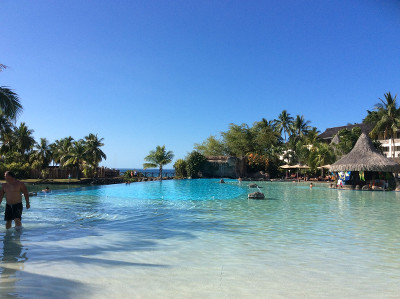 |
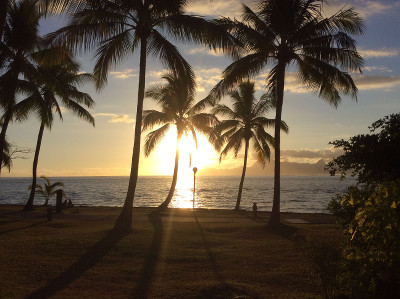 |
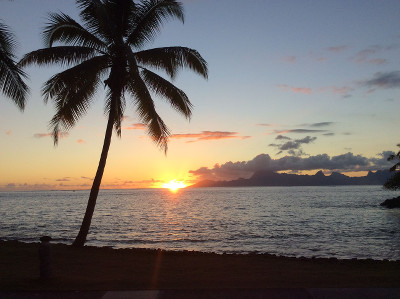 The rest of the trip went well enough with a quiet flight to Los Angeles and another stop-over in my beloved Santa Monica by the sea - though only a short one to have one night in a proper bed between flights, a shopping stroll along Third Street Promenade and another walk along the shore to Venice Beach next morning before returning to LAX (of which I was heartily sick by now).
The rest of the trip went well enough with a quiet flight to Los Angeles and another stop-over in my beloved Santa Monica by the sea - though only a short one to have one night in a proper bed between flights, a shopping stroll along Third Street Promenade and another walk along the shore to Venice Beach next morning before returning to LAX (of which I was heartily sick by now).
Was it worth the immense cost of this luxury jaunt? I don't know. Seeing French Polynesia was certainly a dream come true and I am actually in agreement that it's good to keep prices high there (much like other places such as the Seychelles do) to prevent the kind of mass tourism that has destroyed the natural beauty of so many other areas in the world. And the Paul Gauguin with its amazing service and all-inclusive arrangements (unlike the AIDA, trying to make money from every little extra) did provide value for money.
Though personally, I've realized once more that cruises are, after all, not really my thing. I would have loved to stay on Tahiti longer and explore this island with its many sights fully while Bora Bora or Taha'a despite all the beauty of their dreamy motus had not truly been necessary. So although the Paul Gauguin stood definitely heads and shoulders over AIDA and its utterly German crowd, I still doubt I'll be back on a boat anytime soon - there's just a lot more fun for me in exploring one place properly for some days. And who knows, maybe some day I'll be back on Tahiti to see what I missed the first time round…
Copyright © All Rights Reserved